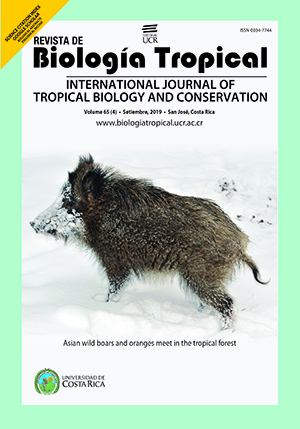Abstract
Introduction: The effects of seasonal upwelling on the conditions of the water column and mesozooplankton communities are poorly understood in the coastal zones of the Eastern Tropical Pacific (ETP), despite the important role of upwelling events in the modulation of productivity in these zones. Objective: To evaluate the influence of seasonal upwelling over the Panama Bight on the structure of the water column and mesozooplankton communities in a tropical cove of the ETP. Methods: Hydrographic data and mesozooplankton samples were collected during four field campaigns in Ensenada de Utría (December 2011, February 2012, October 2013, and February 2013), an estuary located in the Northern Pacific coast of Colombia. Non-parametric and multivariate analyses were used to evaluate seasonal differences in the environmental and biotic variables. Results: Surface waters were warm (> 25 °C) and presented low salinities (< 30) throughout the study period. In contrast, subsurface waters were colder (< 20 °C), saltier (> 33), and presented low dissolved oxygen concentrations (< 2.0 ml l-1) during the dry season (January - March), whereas the water column was homogeneous during the rainy season (April - December). Despite the seasonal changes in the environmental conditions, the expected enhancement in the productivity of the system during the dry season (i.e., higher biomass and abundance of the mesozooplankton) only occurred in February 2012. Contrary to expectations, ichthyoplankton abundance was higher during the rainy season, when the assemblage was dominated by the larvae of anchovy (Cetengraulis mysticetus) and an unidentified Gobiidae. Conclusions: The entrance of upwelled waters into Ensenada de Utría is an important factor modulating the seasonal changes observed in the water column. However, there is high interannual variability in the response of mesozooplankton communities to the upwelling events. Because upwelled waters are oxygen-depleted and more acidic, the entrance of upwelled waters into Ensenada de Utría could be causing physiological stress to the benthic and pelagic organisms inhabiting the deepest zones of the cove. This condition may worsen in the future given the predicted increase of deoxygenation and ocean acidification due to climate change.
##plugins.facebook.comentarios##

This work is licensed under a Creative Commons Attribution 4.0 International License.
Copyright (c) 2019 Bellineth Valencia, Alan Giraldo, Marisol Rivera-Gómez, Vanessa Izquierdo, Andrés Cuellar-Chacón


